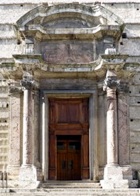

Pietro Carattoli probably trained under the Perugia architect Alessandro Baglioni before moving to Bologna to study architecture, theatre set design and perspectival drawing under Ferdinando Galli da Bibbiena. He then returned to Perugia, where he began his career in ca. 1620.
Although he worked mainly in Perugia, he also produced two designs (1732) for the facade (1733-5) of San Giovanni in Laterano, Rome, which was executed by Alessandro Maria Gaetano Galilei.
Perugia
High Altar of San Domenico (1720)
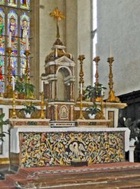
Perspectival frescoes (1724)
Unfortunately, these frescoes in the vaults of the Oratorio dei Santi Simone e Fiorenzo are now under plaster.
Portal of the Duomo (1729)
Palazzo Friggeri (1730)
The design for the building (or perhaps rebuilding) of Palazzo Friggeri is attributed to Pietro Carattoli.
Reconstruction of San Francesco al Prato (1740-88)
Following the collapse of the roof of San Francesco al Prato in 1737, the friars commissioned Pietro Carattoli to rebuild it. The project involved:
-
✴the demolition of what was left of the vaults, which were replaced by a wooden ceiling;
-
✴the reduction (by about two meters) in the height of the perimeter walls;
-
✴the support of these walls using buttresses;
-
✴the construction of a high cylindrical drum crowned by lantern over the crossing; and
-
✴the reconstruction of the campanile.
Frescoes in Palazzo Donini (1745-50)
In the 14 rooms on the piano nobile of Palazzo Donini (including the Salone d’ Onore and the chapel) are mostly attributed to:
-
✴Pietro Carattoli (fictive architecture);
-
✴Nicolò Giuli (decorative elements); and
-
✴Francesco Appiani (figurative scenes).
However, the figurative scene in the sala del caminetto (the room of the fireplace), which depicts Apollo driving his chariot of fiery horses across the sky to give light to the world, is attributed to Giacinto Boccanera. Since he died in 1746, this was presumably the first room on this floor to be decorated. The framing of the fresco (presumably by Pietro Carattoli) makes the most daring use of fictive perspectival architecture in the palace.
Frescoes (1750)
The frescoes in the Oratorio del Crocifisso in Santa Maria Nuova are by Pietro Carattoli and Antonio Maria Garbi.
Palazzo Gallenga Stuart (1748-58)
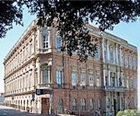
Frescoes (1754-8)
These frescoes by Pietro Carattoli on the “piano nobile” of Palazzo Antinori (now Palazzo Gallenga Stuart) depict allegories of the seasons.
Design of Library of Convento di Monteripido (1754)
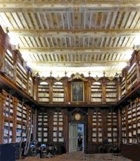
Santa Maria della Misericordia (rebuilt 1760)
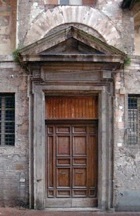
Frescoes in San Pietro (1762-3)
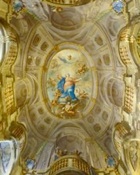
Scenes from the Life of St Augustine (1762)

Palazzo Graziano Monaldi (1765)
Pietro Carattoli was commissioned to restructure this palace in Piazza del Pane (now Piazza della Repubblica), which incorporates the Teatro del Pavone (see below).
Design for Teatro del Pavone (1765)
The first theatre here, the Teatrino del Leon d’ Oro, was built 1717-23, to a design by Alessandro Baglioni, but it proved to be too small. In 1765, the Accademici del Casino commissioned Pietro Carattoli to design a more imposing structure. This new theatre, which was called the Teatro del Pavone (Peacock Theatre) and completed in 1773, was the first brick-built theatre in Perugia. It was also known as the Casino dei Nobili because it catered for the noble families of the city.
Reconstruction of San Fiorenzo (ca. 1766)
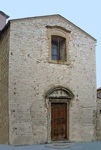
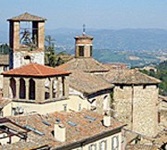
San Fiorenzo was rebuilt in 1768-70, according to a design that Pietro Carattoli completed shortly before his death. The present portal replaced the original double doors at that time. The originally rectilinear apse and transept chapels were reduced in size and given semi-circular floor plans, and two Gothic chapels off the left side of the nave were walled up. [Lantern over the crossing ??]
(The squat tower in the photograph above and to the right belongs to an adjacent palace).
Altars in Santo Spirito (18th century)
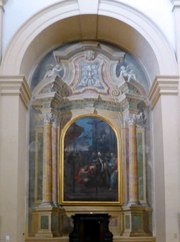
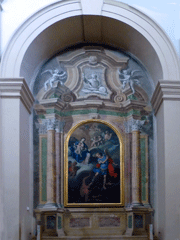
Altare di San Spiridione Altare di San Michele
The frescoed fictive architecture and sculpture above the two altars nearest the entrance of Santo Spirito is attributed to Pietro Carattoli. The designs are very similar, except that:
-
✴the central relief above the Altare di San Spiridione (on the right) depicts the Holy Spirit; while
-
✴that above the Altare di San Michele (on the left) depicts God the Father.
Frescoes (18th century)
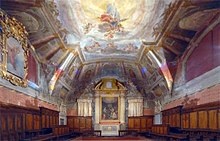
The perspectival frescoes in the upper registers of the walls of the Oratorio dei Nobili of the Chiesa del Gesù (some of which can be seen from a distance in the photograph above) are attributed to Pietro Carattoli.
Assisi
Work in Santa Maria sopra Minerva (1758-9)
The Oratorian Fathers, who acquired Santa Maria sopra Minerva in 1758, commissioned Pietro Carattoli to design:
-
✴the two side altars (1758) in the church; and
-
✴the sacristy (1758-9).
Work in the Refectory of San Francesco (ca. 1760)
After the reconstruction of the “refettorio grande" (large refectory) of the Convento di San Francesco in 1760, Pietro Carattoli designed its stucco decoration (executed by Vincenzo Cenci di Foligno) and also painted the scene of the Confirmation of the Franciscan Rule on the east wall.
